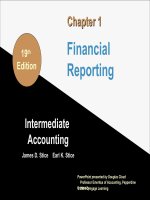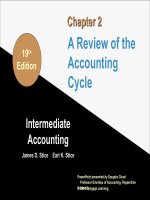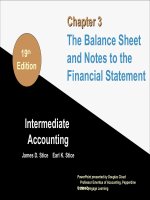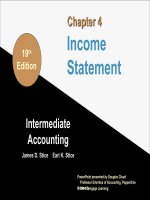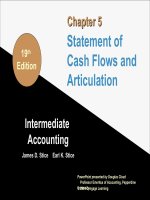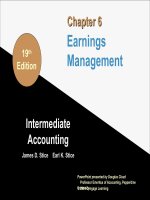Intermediate accounting 19th by stice stice chapter 10
Bạn đang xem bản rút gọn của tài liệu. Xem và tải ngay bản đầy đủ của tài liệu tại đây (214.28 KB, 66 trang )
19th
Edition
Chapter 10
Investments in
Noncurrent
Operating Assets—
Acquisitions
Intermediate
Accounting
James D. Stice
Earl K. Stice
PowerPoint presented by Douglas Cloud
Professor Emeritus of Accounting, Pepperdine
University
© 2014 Cengage Learning
10-1
What Costs Are Included in
Acquisition Cost?
• Noncurrent operating assets are recorded
•
•
initially at cost—the original bargained or cash
sales price.
The cost of property includes not only the
original purchase price or equivalent value but
also any other expenditures required in obtaining
and preparing the asset for its intended use.
Any taxes, freight, installation, and other
expenditures related to the acquisition should be
included in the asset’s cost.
10-2
Land
•
•
•
Costs assigned to land should be those
costs that directly relate to the land’s
unlimited life.
Purchase price, commissions, legal fees,
escrow fees, surveying fees, and
government assessments for water lines,
sewers, and roads are charged to Land.
Clearing and grading costs, including the
removal of unwanted structures, are also
part of the cost of land.
(continued)
10-3
Buildings
•
•
If the structure is purchased ready to use,
charge Buildings for:
Purchase price
Commissions, legal fees, escrow fees, and
reconditioning costs
If newly constructed by an outsider:
Contract price
Legal fees
(continued)
10-4
Equipment
Equipment costs include:
•
•
•
•
The purchase price
Taxes, freight, and insurance during shipping and installation
Special foundations or reinforcing of floors
Reconditioning and testing costs
(continued)
10-5
Intangible Assets
•
•
Intangible assets are those assets (not
including financial assets) that lack
physical substance.
The most important distinction in
intangible assets for accounting
purposes is between those that are
internally generated and those that are
externally purchased.
(continued)
10-6
Trademark
•
A trademark is a distinctive name,
symbol, or slogan that distinguishes a
product or service from similar
products or services.
•
The cost of a trademark includes the
purchase price, filing and registry fees,
and the cost of subsequent litigation to
protect rights. It does not include
internal research and development
costs.
10-7
Franchises
•
•
A franchise is the right received (usually
purchased) by a business or individual to
perform certain functions or sell certain
products or services.
The cost of a franchise includes
expenditures made to purchase the
franchise, legal fees, and other costs
incurred in obtaining the franchise.
10-8
Order Backlog
•
•
The order backlog is the amount of
orders the company has received for
equipment that has not yet been
produced or delivered.
These orders do not constitute sales
because they do not satisfy the
revenue recognition requirement that
the product be completed and shipped.
(continued)
10-9
Goodwill
•
•
Goodwill represents the business
contracts, reputation, functioning systems,
staff camaraderie, and industry experience
that makes the company more than just a
collection of assets.
Goodwill is a residual number, the value of
all of the synergies of a functioning
business that cannot be specifically
identified with any other intangible factor.
10-10
Basket Purchase
•
•
A number of assets may be acquired
in a basket purchase for one lump
sum.
When part of a purchase can be
clearly identified with specific assets,
such a cost assignment should be
made and the balance allocated
among the remaining assets.
(continued)
10-11
Basket Purchase
•
When no part of the purchase price
can be related to specific assets, the
entire amount must be allocated
among the different assets acquired.
10-12
Deferred Payment
•
•
The acquisition of real estate or other
property frequently involves deferred
payment of all or part of the purchase price.
Land is acquired on January 2, 2013, for
$100,000; $35,000 is paid at the time of
purchase, and the balance is to be paid in
semiannual installments of $5,000 plus
interest on the unpaid principal at an annual
rate of 10%.
(continued)
10-13
Deferred Payment
Jan. 2, 2013—Purchased land for $100,000, paying
$35,000 down, the balance to be paid in semiannual
payments of $5,000 plus interest at 10%.
Land
Cash
Notes Payable
100,000
35,000
65,000
June 30, 2013—Made first payment.
Interest Expense
Notes Payable
Cash
3,250
5,000
8,250
$65,000 × 0.05
(continued)
10-14
Deferred Payment
On January 2, 2013, equipment with a cash
price of $50,000 is acquired under a
deferred payment contract. The contract
specifies a down payment of $15,000 plus
seven annual payments of $7,189 each, or a
total cost of $65,323. The present value of
the seven payments at the implicit effective
interest rate of 10 percent is $35,000.
(continued)
10-15
Deferred Payment
On January 2, 2013, purchased equipment with
a cash price of $50,000 for $15,000 down plus
seven annual payments of $7,189 each.
Equipment
Discount on Notes Payable
Notes Payable
Cash
50,000
15,323
50,323
15,000
(continued)
10-16
Deferred Payment
Made first payment of $7,189 on December 31,
2013. Calculations for amortization of debt
discount are as follows:
$50,323 – $15,323 = $35,000; $35,000 × 10% = $3,500
Notes Payable
Cash
7,189
Interest Expense
Discount on Notes Payable
3,500
7,189
3,500
(continued)
10-17
Deferred Payment
Made the second payment of $7,189 and
amortized debt discount on December 31, 2014.
Notes Payable
Cash
7,189
Interest Expense*
Discount on Notes Payable
3,131
7,189
3,131
*$50,323 − $7,189 = $43,134 Notes payable
$15,323 − $3,500 = 11,823 Discount on notes payable
$31,311 Present value of notes payable
at the end of first year
$31,311 × 0.10 = $3,131
10-18
Leasing
•
•
•
A lease is a contract whereby one party (the
lessee) is granted a right to use property owned
by another party (the lessor) for a specified
period of time for a specified periodic cost.
Rental leases are operating leases and
arrangements that are equivalent to a sale of
leased assets are capital leases.
Capital leases are recorded on the acquiring
company’s records as assets, with a related
liability at the present value of the future lease
payments.
10-19
Exchange of
Nonmonetary Assets
• In some cases, an enterprise acquires a
new asset by exchanging or trading
existing nonmonetary assets.
• Monetary assets are those assets whose
amounts are fixed in terms of currency, by
contract, or otherwise (cash, accounts
receivable).
• Nonmonetary assets include all the other
assets (inventories, land).
10-20
Acquisition by Issuing
Securities
• When a fair value for the securities can
be determined, that value is assigned to
the asset acquired.
• In the absence of a fair value for the
securities, the fair value of the asset
acquired is used.
(continued)
10-21
Acquisition by Issuing
Securities
A company issues 1,000 shares of $1 par
common stock in acquiring land; the
stock has a current market price of $45
per share. The entry should be recorded
as follows:
Land
Common Stock
Paid-in Capital in Excess
of Par
45,000
1,000
44,000
10-22
Self-Construction
• Like purchased assets, self-constructed
assets are recorded at cost, including all
expenditures incurred to build the asset
and make it ready for its intended use.
• There is a difference of opinion regarding
the amount of overhead properly
assignable to construction activity.
10-23
Savings or Loss on
Self-Construction
• When the cost of self-construction of an
•
asset is less than the cost to acquire it
through purchase or construction from
outsiders, the difference is not a profit, but a
savings.
When the cost is greater than the cost to
acquire it through purchase or construction
from outsiders, the asset should be
recorded at cost (with some exceptions).
10-24
Interest During Period
of Construction
•
Capitalization of interest is required for
assets, such as buildings and equipment, that
are being self-constructed for an enterprise’s
own use and for assets that are intended to be
leased or sold to others that can be identified as
discrete projects.
•
Interest should not be capitalized for
inventories manufactured or produced on a
repetitive basis.
(continued)
10-25



